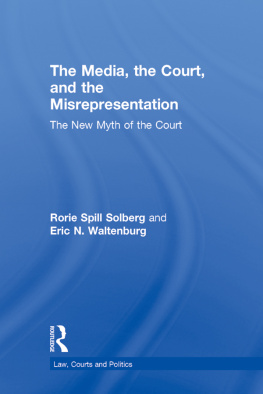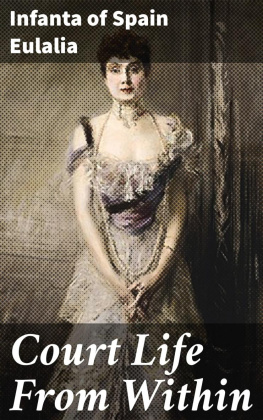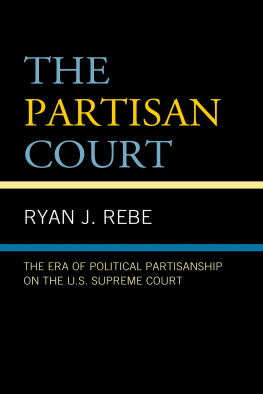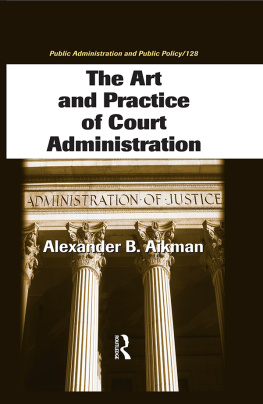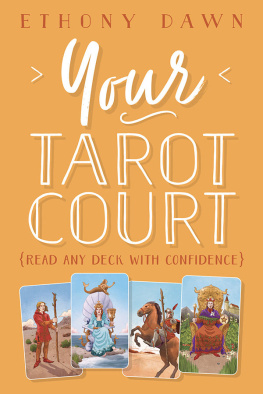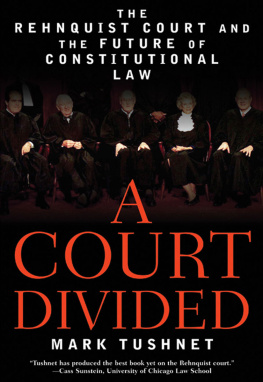The Media, the Court, and the Misrepresentation
The Courts decisions are interpreted and disseminated via the media. During this process, the media paints an image of the Court and its business. Like any artist, the media has license regarding what to cover and the amount of attention devoted to any aspect of the Court and its business. Some cases receive tremendous attention, while others languish on the back pages or are ignored. These selection effects create a skewed picture of the Court and its work, and might affect public attitudes toward the Court. Indeed, studies of media coverage of other governmental institutions reveal that when, and how, their policy decisions are covered has implications for the publics understanding of, compliance with, support for, and cynicism about the policy.
This book uncovers and describes this coverage and compares it to the confirmation hearings, the Courts actual work, even its members. Rorie Spill Solberg and Eric N. Waltenburg analyze media coverage of nominations and confirmation hearings, the justices extra-curricular activities and their retirements/deaths, and the Courts opinions, and compare this coverage to analyses of confirmation transcripts and the Courts full docket. Solberg and Waltenburg contend that the media now cover the Court and its personnel more similarly to its coverage of other political institutions. Journalists still regurgitate a mythology supported by the justices, a cult of the robe, wherein unbiased and apolitical judges mechanically base their decisions upon the law and the Constitution. Furthermore, they argue the media also focus on the cult of personality, wherein the media emphasize certain attributes of the justices and their work to match the publics preferences for subject matter and content. The medias portrayal, then, may undercut the Courts legitimacy and its reservoir of good will.
Rorie Spill Solberg is an associate professor in the School of Public Policy at Oregon State University. She is widely published in journals such as Political Research Quarterly, Social Science Quarterly, Policy Studies Quarterly, and the Journal of Empirical Legal Studies. In 2011, she was selected to edit Judicature, the journal of the American Judicature Society. She received her PhD in American politics with a specialty in judicial politics from The Ohio State University in 1997.
Eric N. Waltenburg is an associate professor of political science at Purdue University. His research interests concern judicial politics and state politics. He has published in such journals as American Politics Research, Political Behavior, and Social Science Quarterly, and he is the author or co-author of three books on judicial politics. He is a co-editor of Politics, Groups, and Identities, the official journal of the Western Political Science Association. He received his PhD from The Ohio State University in 1994 in American politics, with a focus on judicial politics.
To Mason, Chloe and Jacob without whom this book would have been completed much earlier, and I would not change it for the world. I love you all to space and back. Also to Jason, my husband, without his love and support this book would have been completed much later. I love you to space and back too.
Rorie Spill Solberg
To my parents. Things are rarely easy, especially writing. Thanks for teaching me to be perseverant.
Eric N. Waltenburg
Law, Courts and Politics
Edited by Robert M. Howard, Georgia State University
In Democracy in America, Alexis de Tocqueville famously noted that scarcely any political question arises in the United States that is not resolved, sooner or later, into a judicial question. The importance of courts in settling political questions in areas ranging from health care to immigration shows the continuing astuteness of de Tocquevilles observation. To understand how courts resolve these important questions, empirical analyses of law, courts, and judges, and the politics and policy influence of law and courts have never been more salient or more essential.
Law, Courts and Politics was developed to analyze these critically important questions. This series presents empirically driven manuscripts in the broad field of judicial politics and public law by scholars in law and social science. It uses the most up to date scholarship and seeks an audience of students, academics, upper division undergraduate and graduate courses in law, political science, and sociology as well as anyone interested in learning more about law, courts, and politics.
1. The Dual System of Privacy Rights in the United States
Mary McThomas
2. Making Law and Courts Research Relevant
Brandon L. Bartels and Chris W. Bonneau
3. Europeanization of Judicial Review
Nicola Ch. Corkin
4. The Media, the Court, and the Misrepresentation
The New Myth of the Court
Rorie Spill Solberg and Eric N. Waltenburg
First published 2015
by Routledge
711 Third Avenue, New York, NY 10017
and by Routledge
2 Park Square, Milton Park, Abingdon, Oxon OX14 4RN
Routledge is an imprint of the Taylor & Francis Group, an informa business
2015 Taylor & Francis
The right of Rorie Spill Solberg and Eric N. Waltenburg to be identified as authors of this work has been asserted by them in accordance with sections 77 and 78 of the Copyright, Designs and Patents Act 1988.
All rights reserved. No part of this book may be reprinted or reproduced or utilized in any form or by any electronic, mechanical, or other means, now known or hereafter invented, including photocopying and recording, or in any information storage or retrieval system, without permission in writing from the publishers.
Trademark notice: Product or corporate names may be trademarks or registered trademarks, and are used only for identification and explanation without intent to infringe.
Library of Congress Cataloging-in-Publication Data
Solberg, Rorie Spill, 1969 author.
The media, the court, and the misrepresentation : the new myth of the court /
Rorie L. Solberg, Eric N. Waltenburg.
pages cm. (Law, courts and politics ; 4)
Includes bibliographical references and index.
1. United States. Supreme CourtPress coverageUnited States.
2. Courts of last resortPress coverageUnited States. 3. Judicial process
United States. I. Waltenburg, Eric N., 1965 author. II. Title.
KF8748.S5382014
347.7326dc232014025500
ISBN: 978-0-415-82337-1 (hbk)
ISBN: 978-1-138-83123-0 (pbk)
ISBN: 978-0-203-55172-1 (ebk)
Typeset in Bembo
by Apex CoVantage, LLC
Contents
Many people had a hand in the completion of this manuscript. In particular, Solberg wishes to thank Dan West (a graduate student), Karli Olsen, Jandee Todd, Nicholas Martinez, and Dan Cushingall of whom worked on one part or another of the data collection. She also appreciates the support from the University Honors College and the School of Public Policy at Oregon State University. Waltenburg would like to acknowledge the hard work of Walter Schostak (who worked on the project as a Wilke Undergraduate Research Scholar) and Mariliz Kastberg-Leonard for her tireless and cheerful data entry. He is also indebted to the Purdue Department of Political Science.
1
Introduction: The Myths of the Court
It stands majesticfour stories tall, longer and wider than a football field, and built almost entirely of gleaming marble from three continents. Huge statues guard the stairs leading to its main entranceon the left, a female holding a book of laws and a small set of scales (the Contemplation of Justice ); on the right, a male with a tablet of laws and a sheathed sword (the Authority of Law ). At the top of the stairs, 16 Greek Corinthian columns support the pediment. Equal Justice Under Law is inscribed on the architrave. Capping this entrance is a sculpture group of six figures representing liberty, order, and authority. Bronze doors weighing six and a half tons allow entry into the main corridor, known as the Great Hall, on either side of which are double rows of columns rising high to a coffered ceiling. At the Great Halls east end, oak doors open into the Court Chamber. The area of this room is over 7,500 square feet, and has a ceiling that rises 44 feet above the floor. It is a study in marble and mahogany. Twenty-four marble columns stand inside. The Chambers walls are marble and covered with friezes, and there are marble borders along the floor. The raised benchwhich is the rooms focal pointand the other furniture are mahogany. The room, like the building itself, is opulent, designed to communicate gravity, stature, and prestige. This Marble Palace is the structural equivalent of the cult of the robe and supports the myth of legality.

